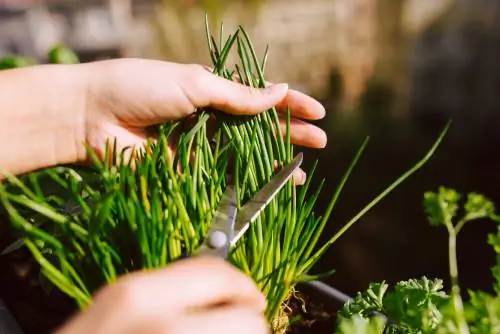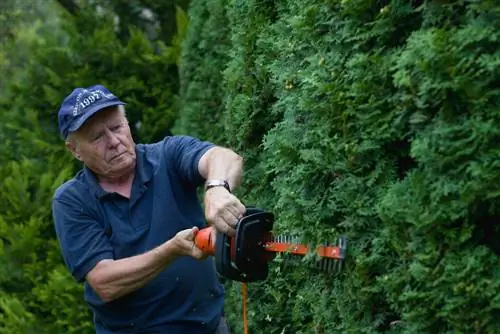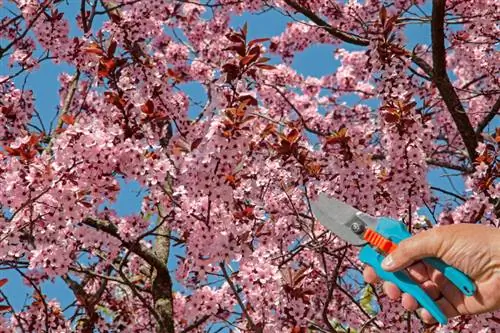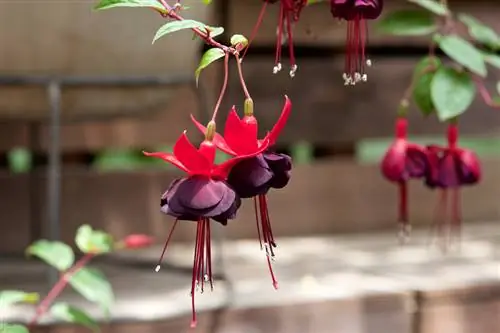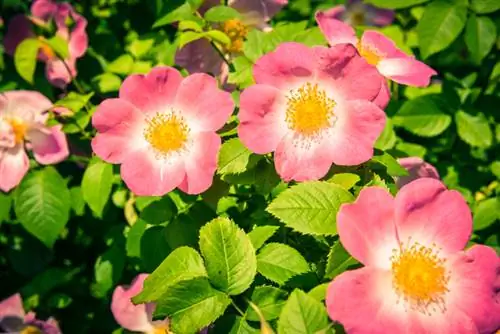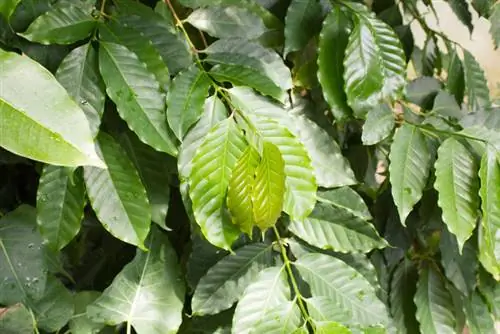- Author admin [email protected].
- Public 2023-12-16 16:46.
- Last modified 2025-01-23 11:21.
A feast for the eyes and palate, chives are one of the most valuable garden treasures. The multifaceted attributes of the popular herb plant benefit from pruning at the right time. Read this tutorial about when and how to cut chives correctly.
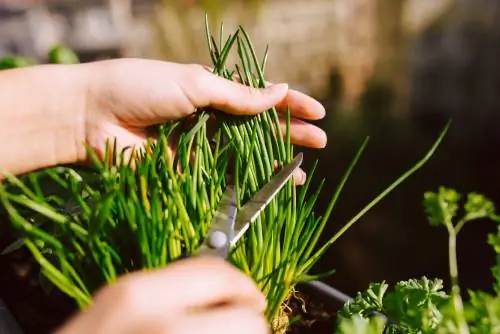
How do I cut chives correctly?
Cutting chives: Start as soon as the leaf length has reached 15-20 cm and cut regularly up to two fingers' width above the ground. Be sure to remove budding shoots in a timely manner and always use a sharp cutting tool such as bypass scissors.
Chive blossom and rumor mill
There are myths and rumors surrounding the splendor of chive flowers. It is said that flowering chives are poisonous or at least inedible. We invite you to a short excursion that clears up misconceptions and misunderstandings about chive flowers.
When the picturesque flowering period begins in June, chives go through a transformation process. Until then, the local herb plant will delight you with its juicy, tender tubular leaves, which add a special flavor to many dishes. As buds begin to form, strong stems rise above the grassy clump and have to bear a heavy load of flowers. For this purpose, the tubes become thicker, stronger and woody. The fresh, spicy taste falls by the wayside. Anyone who tastes a stem will be disappointed by the bitter taste. This does not mean that the flower tubes are poisonous.
Chives invest all their energy in the flowers, so that neighboring leaves are affected. The characteristic aroma is gradually lost and the tubes take on a woody consistency. The stalks are still suitable for consumption, although no longer in spring-fresh premium quality. The violet flower heads, which give cold dishes a special pep, ensure a culinary delight.

Pruning care as a culinary herb
If the focus is on using chives as a culinary herb, the pruning care aims to delay theflavor-destroying flowering period. As long as the plant does not form buds or flowers, the juicy tubular leaves benefit from the valuable plant energy. How to properly cut chives as a culinary herb:
- Cut regularly from a leaf length of 15-20 cm
- Cut the stalks back to two fingers' width above the ground
- Important: chivesnever pluck out
If you notice the first stems with buds when harvesting, cut the shoots back to 2 centimeters. Fresh leaves emerge from each interface. As long as there are no flower stalks embedded in them, the delicate, spicy herbal enjoyment remains.
Background
Cut chives with bypass scissors
The smoother you cut the juicy tubular leaves, the better the harvest quality. A pair of scissors with a bypass mechanism should be available for every cut of chives. In this version, the tool has two sharp blades that cut the herbaceous tissue smoothly even when it is already woody. Alternatively, use a sharp kitchen knife. Anvil scissors with one sharp and one blunt side are not recommended for cutting and harvesting, as they are likely to cause bruising to the chives.
Autumn pruning promotes winter seasoning enjoyment
As a native perennial, chives absorb their herbaceous plant parts in the bed before winter. Only the root ball with its many frost-resistant bulbs overwinteres in the protection of the soil. So that you don't have to miss out on fresh herbal pleasure during the cold season, the following strategy has proven itself well:
- Cut off a piece with a hand shovel or knife and dig it out
- Cut all shoots back to 2 cm
- Plant the ball with several onions in a pot with herb soil and water it
The chives that have been put away continue their growth on the bright, warm windowsill. Adjust the water and nutrient supply to the reduced light conditions. When pruning, continue to look for flower stalks. Where the herb plant feels in good hands, attempts at winter flowering are not uncommon, with all the negative consequences described for spicy culinary delights.
Tip
Delaying the flowering period through pruning often results in a surplus harvest that the kitchen cannot process immediately. By freezing the fresh leaves, you can create a tasty supply. Rinse the stalks with clean water and cut them into small pieces. Filled into a freezer container and frozen in the freezer, the distinctive aroma remains almost completely intact for many weeks.
Pruning care as a flowering perennial
Gardeners without a penchant for the spicy herb taste still integrate chives into their imaginative planting plan. It is the lavish and colorful flowering period that sets decorative accents in the perennial bed. Now the purple flower heads are very welcome, so a different cut comes into focus. This is how you cut chives as a flowering perennial:
- Best time is in late autumn
- Important: all parts of the plant must be completely absorbed and dead
- Clutch the leaves in one hand
- Cut back to 5 cm using a perennial sickle or knife
Withered chives are undoubtedly only a shadow of their former self. However, you should be patient with pruning until all the leaves have dried up. In this transition phase, the perennial shifts all nutrient reserves from the above-ground shoots into the underground survival organs in the form of bulbs. The fuller the energy deposits, the more lush the fresh shoots and more opulent the flowers next year.
Cut ornamental onions like chives
A close relative complements the splendor of chive flowers perfectly. Ornamental allium is also part of the versatile Allium genus. Its trademark are large, purple flower balls that float through the herbaceous bed at eye level. The first leaves come in during the flowering period. To ensure that any resulting gaps are closed decoratively, chives are useful as an underplant. In late autumn, cut both perennials back to just above the ground in one go.
Excursus
Division preserves youthful perennial freshness
Regardless of whether you grow chives as an herb plant or a flowering beauty, you should divide the perennial every few years. The best time is in autumn, when pruning is already on the care program. Shorten all shoots to two fingers' width above the root disc. Then dig up the root network. Pull the ball apart with both hands to gently separate the numerous onions. Plant each section in the new location. Thanks to this rejuvenation treatment, your chives will take off again with fresh vigor.
Frequently asked questions
Are chive flowers edible?
Gardening practice has proven that the flowers are edible and very tasty. There is a persistent rumor that chives are no longer suitable for consumption once they bloom. In fact, the fresh stalks are particularly aromatic just before the flowering period begins. Over time, the aroma is lost and the stalks become woody. Chives can still be used as a culinary herb as long as you do not eat the flower stems.
I would like to plant chives as a flowering perennial, but also use them as a culinary herb. Can that succeed? It is often said that chives should not bloom if you want to eat them
You can definitely make chives bloom. The flowers are not only decorative, but also edible. However, after the flowering period begins, the stalks become slightly woody and lose their taste. Optionally, you can cut back the herb plant, whereupon fresh stalks will sprout and can be harvested. Alternatively, cut back one half of the perennial and enjoy the flowers on the other half.
I harvested my magnificent chives in the pot regularly, but did not cut them radically after the flowering period. Now the plant is wilted and spotty. What to do?
Premium quality chives require regular pruning. The plant grows vigorously again within a week and provides aromatic replenishment for the kitchen. Therefore, cut back all shoots and apply an organic herbal fertilizer.
Is chives hardy and perennial?
Chives are a native perennial and are therefore reliably hardy. To this day, wild species can still be discovered in the wild in wet meadows and river floodplains. In winter the above-ground, herbaceous shoots move in. Only the frost-resistant root ball with many bulbs overwinters deep in the ground and sprouts again next spring.
Should I provide winter protection for chives in the bed after the last cut?
In the year of planting, it is advantageous to cover the bed with a thick layer of leaves and coniferous twigs. This protects the delicate onions from severe frost and constant wetness, especially in harsh winter regions. From the second or third year onwards, the herbaceous perennial has established itself to the point where it can survive the winter on its own. This does not apply to chives in the pot. Behind the vessel walls, the bulbs are vulnerable to the bitter cold. A warm winter coat made of fleece effectively prevents frost damage.
The 3 most common cutting mistakes
Chives will not live up to their reputation as a herbal treasure if you give them free rein to form flowers. This table shows you which other cutting errors affect the premium quality:
| Cutting errors | malicious image | Prevention |
|---|---|---|
| Budding shoots not thinned out | early end of the aromatic premium quality | Cut off shoots with buds and flowers promptly |
| Tube leaves plucked out | lower crop yield, total failure | always cut 2-5 cm above the ground |
| blunt cutting tool used | bruised leaves, rot formation | Use a sharp knife or bypass scissors |
Tip
Starting with the first harvest cut, young tubular leaves often sprout with brown tips. This is not a cause for concern, but rather a normal reaction to the previous cut into the succulent plant tissue. If you are bothered by the purely aesthetic impairment, simply cut off the brownish leaf tips before eating.

